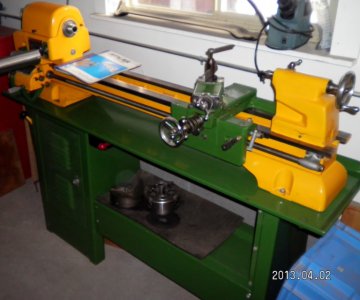Chuck,
The date in the bed casting is the casting date (and the 058-016 is the casting number). Which according to a statement in most if not all editions of the Atlas MOLO is typically two years earlier than when the bed casting is actually machined and used. This was the casting "seasoning" period. Plus the 101.28910 was first built in 1967, the year of the last significant change in the machines when they added the lever for engaging power cross feed, added the slip clutch, and changed the right leadscrew bearing to the final multi-piece version.
When the 1/2" bed 12" machines first came out in late 1957, the serial numbers started at 000001. When the final revision came out, the serial number range was incremented to either 100000 or more likely 100001. So your machine is the 786th one built. Which means either late 1967 or perhaps more likely early 1968.
Because Atlas or Timken apparently stopped hand engraving the bearing receipt inspection dates onto the bearing cups and cones around 1957 or so, absent the original invoice showing your machine's serial number, that's as close as we can get to saying when yours was built. FYI, to date, no 1/2" bed machine has been reported as having bearing dates.
Note that this is the earliest serial number for any model of the final version of the late 12".
With a simple inspection, you could add some info to a different dating subject. In case you don't yet know, a "gib" is a relatively thin strip with adjusting screws to move it slightly. One is typically used to adjust the "fit" of a part that slides relative to the part that it is attached to or sits on. On all of the Atlas built lathes, there are four. The one on tailstock between it and the vertical front of the rear way and the one on the carriage between it and the rear of the rear way are both rectangular (meaning that the front and rear gib sufaces are perpendicular to the top and bottom). The one on the carriage slide or cross slide (different names for the same part) between it and the carriage dovetail, and the one on the compound slide between it and the dovetail on the compound swivel are trapezoidal, meaning that two narrow edges are not perpendicular to the two ones.
Originally, all four gibs were made of steel. The carriage gib and the tailstock gib remained steel through the end of Atlas lathe production. The cross slide gib and the compound slide gib were changed to plastic sometime during production of the 1/2" bed 12" machines. This probably happened in the late 1970's but would you look at the front ends of the two gibs and report whether they are steel or plastic?
I'll open this question up to anyone with one of the 1/2" bed lathes. Take a look at the machine and if it does have plastic gibs, send me the serial number.




